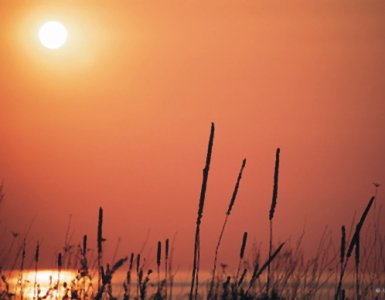
Wind turbines that would float at sea
In the News
Printer Friendly Page
The aesthetics of wind turbines remains a controversial topic, but researchers at the Massachusetts Institute of Technology (MIT) are posing one possible solution: a grouping of 400 large offshore wind turbines that would provide enough electricity to power several hundred thousand homes, yet remain out of sight of the shore.
The way to do this would be to float the turbines on platforms 100 miles (161 kilometers) out to sea where the winds are strong and steady. Current offshore wind turbines typically need to stand on towers driven deep into the ocean floor, so they need to be in waters only 15 meters (49 feet) deep or less. That means proposed installations are close to shore and may invite public opposition.
Paul Sclavounos, MIT professor of mechanical engineering and naval architecture, has applied his work in large floating structures for deep-sea oil and gas exploration to the problem.
The resulting design uses a tension leg platform, a system in which long steel cables or tethers connect the corners of the platform to a concrete block or other mooring system on the ocean floor. The platform and turbine are supported by buoyancy rather than a tower like current systems.
There are challenges to the plan. Ocean assembly would be prohibitively expensive because of the large size of the devices: the wind tower is 90 meters (250 feet) tall and the rotors about 140 meters (459 feet) in diameter. So the researchers have designed them to be assembled onshore, likely at a shipyard, and towed out to sea.
Sclavounos hopes to install a half-scale prototype south of Cape Cod at some point.
United Nations adopts sustainable fisheries resolution
The United Nations General Assembly on Dec. 8, 2006, called on nations to take “immediate action” to sustainably manage fish stocks and protect vulnerable deep sea ecosystems from harmful fishing practices. It also denounced overfishing, illegal catches, wasteful methods and destructive techniques that it said were leading to the rapid depletion of fish stocks and spoiling fragile marine habitats in many parts of the world. For information see the draft on sustainable fisheries at: http://www.un.org/Docs/journal/asp/ws.asp?m=A/61/L.38.
UPDATE: Chlorine spill kills fish in Mill Creek
By Lisa Capone
Mill Creek in Chelsea, Massachusetts, is recuperating from a chlorine spill that killed thousands of fish and other organisms in late August 2006. The source of the spill remains a mystery, said Chelsea City Councilor Roseann Bongiovanni, project manager for the Chelsea Green Space and Recreation Committee (see, “Tipping the scales,” Fall 2006 issue).
“Environmental experts told us the creek would bounce back pretty quickly. The concern is making sure that this doesn't keep happening,” Bongiovanni said.
Bongiovanni recently spearheaded a project to restore the Mill Creek Salt Marsh by dredging contaminated sediments at the head of the urban waterway, removing invasive Phragmites (common reed) from an adjoining salt marsh, and planting native Spartina grass. With that project well under way, Bongiovanni and other community members were planning a companion project to restore another nearby salt marsh when the Mill Creek fish kill was discovered. State and federal agencies investigated, but have been unable to identify possible sources of the spill.
The good news, said Eric Hutchins, Gulf of Maine habitat restoration coordinator for the National Oceanic & Atmospheric Administration, is that “the species that were impacted were relatively resilient.” He said Mill Creek's native fish populations should rebound in about a year, and worms and clams in about two years.
Lisa Capone is a free-lance writer in Melrose, Massachusetts, who specializes in science and the environment.
|
|
||
| R. Scott Sherman, an outdoor photographer and volunteer for the New Hampshire Marsh Monitors’ program, shares his enjoyment of Rye Beach, New Hampshire, at sunrise (above). “For me, doing volunteer work as a marsh monitor brings me one step closer to our wonderful seacoast. The knowledge I have received is indispensable,” he said. “I look forward to helping out next year, too.” See more of Scott's photos at: http://www.rscottphoto.net | |||
 |
PHOTO: TOM KLEINDINST, WOODS HOLE OCEANOGRAPHIC INSTITUTION |
Cape Cod ferries board science mission
Ferries that travel between Cape Cod, Massachusetts, and the nearby islands of Martha's Vineyard and Nantucket recently took on an added role: that of research vessels.
Woods Hole Oceanographic Institution biologists have installed a package of sensors on the 235-foot Katama ferry to measure water quality and to photograph plankton as the ferry crosses Nantucket Sound year-round, several times a day. Other ferries also will be outfitted with an instrument pack.
© 2007 The Gulf of Maine Times

